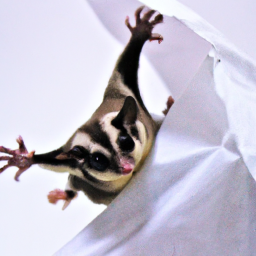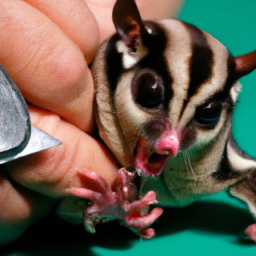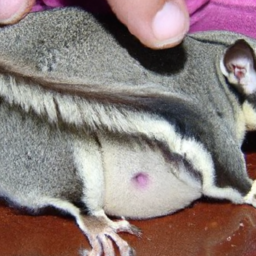What Is The Lifespan Of Sugar Glider
In this article, we will explore the lifespan of sugar gliders and provide you with some valuable information on how long these adorable creatures typically live. You will learn about the factors that can influence their lifespan, such as diet, habitat, and overall health. We will also discuss some essential tips to help you ensure that your sugar glider lives a happy and healthy life for as long as possible. So, let’s dive right in and discover just how long these fascinating little animals can grace our lives.
What Is the Lifespan of Sugar Gliders?
Sugar gliders are small, nocturnal marsupials native to Australia, New Guinea, and Indonesia. These adorable little creatures are known for their unique ability to glide through the air, thanks to a flap of skin between their forelimbs and hindlimbs. Sugar gliders have become increasingly popular as pets due to their small size, playful nature, and close bond with their owners. If you’re considering getting a sugar glider as a pet, it’s important to understand their lifespan and the factors that can affect it.
Physical Characteristics
Sugar gliders are small animals, typically measuring around 5-6 inches in length, with a tail that can be equally as long. They have large, round eyes and ears, which are adaptations for their nocturnal lifestyle. Sugar gliders have soft, silky fur that is usually grey, brown, or black, with a cream-colored belly. Additionally, they have a distinctive flap of skin called a patagium, which stretches from their wrists to their ankles, allowing them to glide through the air.
Habitat and Diet
In the wild, sugar gliders inhabit the canopy layer of forests, where they spend most of their time. They are arboreal animals, meaning they live and move through trees. Sugar gliders are omnivorous, feeding on a variety of foods including nectar, tree sap, insects, fruit, and small vertebrates. It is important to replicate their natural diet as much as possible when keeping them in captivity.
Factors Affecting Sugar Glider Lifespan
Various factors can influence the lifespan of sugar gliders, including genetics and the quality of care and husbandry they receive.
Genetics
Just like humans and other animals, genetics play a significant role in determining the lifespan of sugar gliders. Some individuals may be more predisposed to certain health issues or have weaker immune systems, leading to a shorter lifespan. It is important to choose your pet sugar glider from a reputable breeder who practices responsible breeding to ensure you have a healthy glider with a longer lifespan.
Quality of Care and Husbandry
The quality of care and husbandry a sugar glider receives also has a significant impact on its lifespan. Proper nutrition, regular veterinary care, and an enriched environment are essential for promoting longevity in sugar gliders. Owners must provide a balanced diet, plenty of exercise opportunities, and social interaction to ensure their sugar glider remains healthy and happy.
Average Lifespan of a Sugar Glider
The average lifespan of sugar gliders can vary depending on whether they are living in the wild or in captivity.
In the Wild
In their natural habitat, sugar gliders have an average lifespan of 4-6 years. However, this can be significantly shorter due to predation, food scarcity, and other environmental factors. In the wild, sugar gliders face numerous challenges that can limit their lifespan.
In Captivity
With proper care and nutrition, sugar gliders can live much longer in captivity. On average, pet sugar gliders have a lifespan of 12-15 years. Some sugar gliders have been known to live even longer, reaching up to 20 years or more. By providing a suitable environment, social interaction, and regular veterinary care, you can greatly increase the lifespan of your pet sugar glider.
Signs of Aging in Sugar Gliders
As sugar gliders age, they may experience both physical and behavioral changes.
Physical Changes
Physically, older sugar gliders may develop graying fur, lose muscle tone, and experience weight loss. They may also be more prone to dental issues and other age-related health problems. Regular check-ups with a veterinarian experienced with exotic animals are essential to monitor and address any physical changes as your sugar glider ages.
Behavioral Changes
Sugar gliders are social animals and thrive on interaction with their owners or other gliders. As they age, they may become less active and more sedentary. They may also show signs of decreased energy levels and have a reduced interest in play. It is important to provide them with an enriched environment and continue social interaction to ensure their mental and emotional well-being.
Promoting Longevity in Sugar Gliders
While genetics and age-related changes are inevitable, there are steps you can take to promote longevity in your sugar glider.
Proper Nutrition
A balanced and varied diet is crucial for ensuring your sugar glider receives essential nutrients. The diet should consist of a combination of fresh fruits, vegetables, a high-quality pellet food, and a small amount of protein. Avoid feeding them foods high in sugar, fat, or salt, as these can be detrimental to their health. It is also important to provide fresh water at all times.
Regular Veterinary Care
Regular visits to an experienced exotic animal veterinarian are essential for detecting and preventing health issues. Your veterinarian can advise you on potential signs of illness, conduct routine health screenings, provide vaccinations, and offer guidance on appropriate care for your aging sugar glider.
Lifespan Variations among Sugar Gliders
The lifespan of sugar gliders can also vary due to gender differences and environmental factors.
Gender Differences
Female sugar gliders tend to have longer lifespans than males. Females have a natural advantage as they do not undergo the hormonal and physical stress of reproduction. Neutering males can help extend their lifespan and prevent certain health issues, such as testicular tumors.
Environmental Factors
The environment in which a sugar glider is kept can also affect its lifespan. A well-maintained, hygienic enclosure with ample space, appropriate bedding, and toys for stimulation can contribute to a longer and healthier life. Avoid exposure to extreme temperatures, drafts, and other potential hazards that could compromise your glider’s well-being.
Common Health Issues That May Shorten Lifespan
Certain health issues are more common in sugar gliders and may contribute to a shortened lifespan.
Nutritional Deficiencies
Sugar gliders are prone to calcium, vitamin D, and protein deficiencies. These nutritional imbalances can lead to health problems such as metabolic bone disease, lowered immune function, and reproductive issues. Providing a balanced and nutritious diet is crucial in preventing these deficiencies.
Parasites and Infections
Internal and external parasites, such as mites and fleas, can affect the health and lifespan of sugar gliders. Regular veterinary check-ups, proper hygiene practices, and providing a clean and sanitized environment can help prevent infestations and infections.
Factors That Can Extend Sugar Glider Lifespan
Various factors can help extend the lifespan of sugar gliders, allowing them to enjoy a longer and healthier life.
Enriched Environment
Providing an enriched environment with plenty of toys, climbing structures, and opportunities for exercise can help keep sugar gliders mentally stimulated and physically active. This can contribute to their overall well-being and help prevent age-related health issues.
Social Interaction
Sugar gliders are highly sociable animals and thrive on social interaction. Regular playtime and bonding with their owners or other gliders can have a positive impact on their mental health and happiness. Loneliness and lack of companionship can lead to stress and depression, which can affect their overall lifespan.
Caring for Aging Sugar Gliders
As sugar gliders age, they may require additional care and attention to maintain their health and well-being.
Special Dietary Needs
Older sugar gliders may require dietary adjustments to accommodate their changing nutritional needs. This may include softer food options or supplements to aid digestion and ensure they receive adequate nutrients.
Adapting the Environment
As sugar gliders age, they may have difficulty climbing or navigating through their enclosure. Providing lower perches and additional platforms can make it easier for them to move around and prevent falls or injuries. You may also consider adding softer bedding to provide additional cushioning.
Does the Bonding Process Affect the Lifespan of a Sugar Glider?
The sugar glider bonding timeline is crucial for their overall well-being. Proper bonding can greatly affect the lifespan of a sugar glider, as it can lead to reduced stress, better health, and a stronger bond with their human caretaker. It’s important to be patient and consistent during the bonding process.
Conclusion
The lifespan of sugar gliders can vary depending on genetics, quality of care, and environmental factors. With proper nutrition, regular veterinary care, an enriched environment, and social interaction, sugar gliders can live long and healthy lives. Understanding their needs and providing the appropriate care can help you enjoy a wonderful and rewarding relationship with your sugar glider for many years to come.





